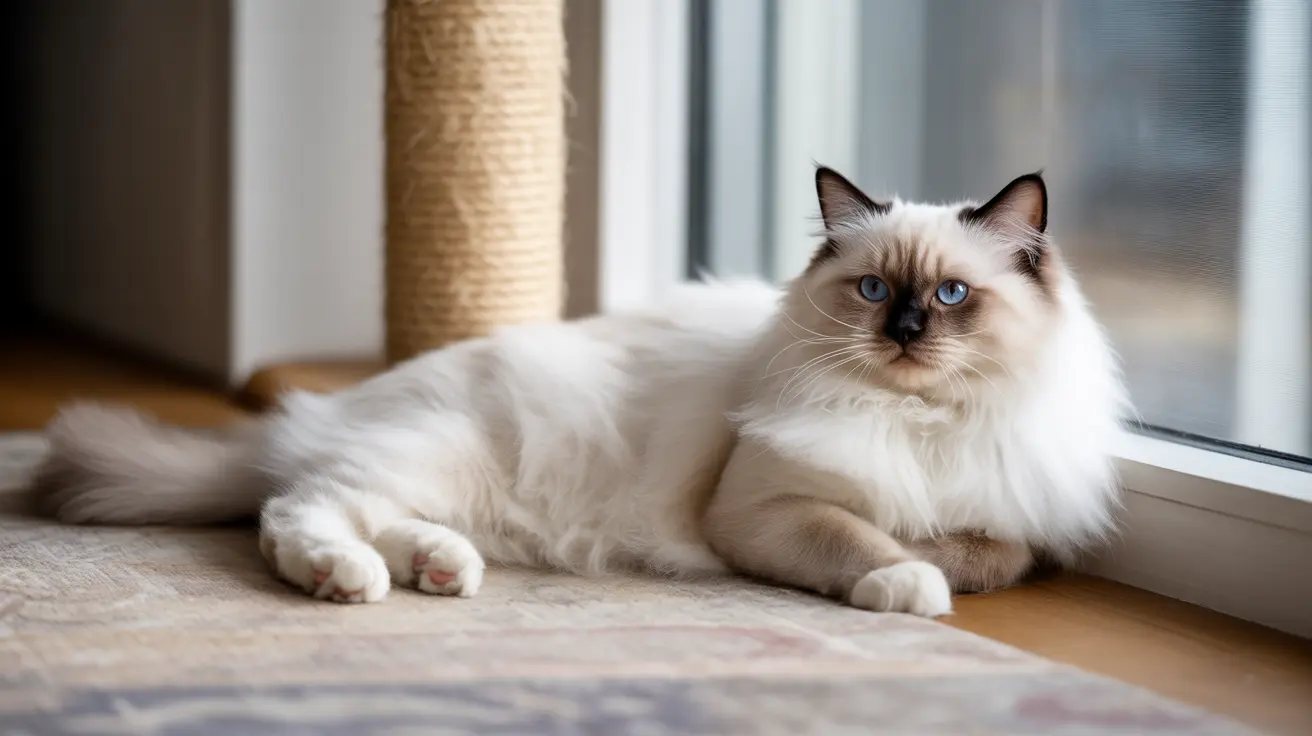Stress in Cats: Signs and Remedies for a Happy, Healthy Feline
As devoted cat parents, we often marvel at our feline companions' seemingly carefree nature. However, beneath that composed exterior, cats are actually quite sensitive creatures capable of experiencing a wide range of emotions, including stress. Understanding stress in cats, its signs, and effective remedies is crucial for maintaining your pet's physical and mental well-being while fostering a harmonious home environment.
Stress represents the psychological and physical strain placed on your cat when exposed to negative environmental conditions. Unlike humans who can verbally express their distress, cats communicate their anxiety through subtle behavioral and physical changes that require careful observation to detect. By learning to recognize these signs early and implementing proven stress-reduction strategies, you can significantly improve your cat's quality of life and prevent stress-related health complications.
This comprehensive guide will explore the common triggers of feline stress, help you identify the warning signs, and provide practical, science-backed remedies to create a calm, supportive environment for your beloved companion.
Understanding the Common Causes of Cat Stress
Before diving into stress management, it's essential to understand what triggers anxiety in our feline friends. Cats are naturally adaptable creatures, but they're also highly sensitive to changes in their environment and social dynamics. Recognizing these stress triggers allows you to either prevent them or minimize their impact on your cat's well-being.
Environmental and Territorial Stressors
One of the most significant sources of stress for cats involves territorial threats and environmental changes. The introduction of new pets or babies into the household can disrupt your cat's sense of security and territorial boundaries. Similarly, major environmental changes such as moving to a new house, home renovations, or construction work can create lasting anxiety.
Multi-cat households present unique challenges, as competition for resources like food, water, and litter boxes can create chronic stress. Even subtle changes in familiar scents around the home can trigger anxiety, as cats rely heavily on scent markers to feel secure in their territory.
Social and Routine Disruptions
Cats thrive on predictability and routine. Irregular feeding schedules, inconsistent litter box maintenance, or disruptions to their daily patterns can cause significant stress. Over-handling or forced interactions, particularly with cats who prefer limited human contact, can also contribute to anxiety levels.
Recognizing the Signs of Stress in Your Cat
Stress in cats can manifest through various behavioral and physical changes, and these signs can be quite subtle. Understanding these indicators is crucial for early intervention and preventing chronic stress-related health issues.
Behavioral Changes
Increased vocalizations represent one of the most noticeable signs of feline stress. Stressed cats tend to become more vocal, exhibiting frequent meowing, yowling, hissing, and growling. While meows and yowls may be cries for help or attention, hissing and growling clearly indicate that your cat feels threatened or defensive.
Excessive grooming is another common stress response. Cats may groom themselves compulsively to release endorphins and self-soothe, sometimes to the point of creating skin irritation or bald patches. This behavior serves as a coping mechanism but can become problematic when taken to extremes.
Urinating outside the litter box often signals stress, as cats may seek comfort through marking territory or simply feel too anxious to use their designated bathroom area. However, it's crucial to rule out medical causes such as urinary tract infections or kidney issues through veterinary examination before attributing this behavior solely to stress.
Physical and Emotional Symptoms
Stressed cats may display aggression through behaviors such as stalking, pouncing, scratching, or biting. This defensive behavior often stems from feeling overwhelmed or threatened. Additionally, some cats respond to stress by hiding and becoming less engaged with their family, seeking refuge in secluded areas where they feel safer.
Physical symptoms of stress can include changes in appetite and water intake, as cortisol release suppresses appetite and may cause nausea. Low energy levels are also common, with stressed cats sleeping more than usual to cope with the physical strain of anxiety. Digestive issues, including diarrhea and vomiting, can result from stress-induced inflammation in the gastrointestinal tract.
Body Language Indicators
Subtle changes in body language often provide the earliest clues to feline stress. Watch for flattened ears, dilated pupils, and a tense body posture. These physical signs, combined with behavioral changes, paint a clear picture of your cat's emotional state and can help you intervene before stress becomes chronic.
The Health Impact of Chronic Stress
Prolonged stress doesn't just affect your cat's behavior—it can have serious consequences for their physical health. Chronic stress weakens the immune system, making cats more susceptible to infections and illnesses. It can also contribute to urinary tract infections, gastrointestinal problems, and skin conditions, all of which further compromise your pet's quality of life.
Understanding that stress-related health issues can create a cycle where physical discomfort increases anxiety levels emphasizes the importance of addressing stress promptly and comprehensively.
Creating an Optimal Litter Box Environment
The litter box represents a critical aspect of your cat's daily routine and comfort level. Inadequate litter box conditions can be a significant source of stress, while an optimal setup promotes confidence and well-being.
Essential Litter Box Guidelines
Provide multiple litter boxes throughout your home—ideally one per cat plus one extra. This ensures adequate access and reduces competition in multi-cat households. Each box should be kept meticulously clean, as cats are naturally fastidious creatures who may avoid soiled facilities.
Location matters significantly for litter box success. Place boxes in quiet, easily accessible areas away from food and water stations. Ensure each box offers some privacy while remaining easily reachable, particularly important for senior cats or those with mobility issues.
Effective Stress Reduction Strategies
Managing stress in cats requires a multi-faceted approach that addresses both environmental factors and your cat's emotional needs. The following strategies have proven effective in reducing feline anxiety and promoting overall well-being.
Environmental Enrichment
Providing comprehensive environmental enrichment gives your cat opportunities to engage in natural behaviors while building confidence. Cat trees offer vertical territory and climbing opportunities, while interactive toys and puzzle feeders provide mental stimulation and prevent boredom.
Scratching posts and pads allow cats to mark territory naturally and maintain their claws, reducing frustration. Safe hideaways, such as covered beds or cardboard boxes, give anxious cats secure retreat options when they need to decompress.
Routine and Predictability
Establishing and maintaining consistent daily routines significantly reduces stress by providing predictability. Feed your cat at regular intervals, clean litter boxes on a schedule, and try to maintain consistent sleep and activity patterns. This predictability helps cats feel secure and reduces anxiety about uncertainty.
Resource Management
Ensure adequate resources throughout your home to minimize competition and territorial disputes. This includes providing multiple feeding stations, water sources, comfortable resting areas, and scratching surfaces. Strategic placement of these resources can help cats avoid conflict and maintain their individual territories within your home.
Calming Aids and Professional Support
Several scientifically-backed calming aids can supplement environmental management in reducing feline stress. Pheromone diffusers release synthetic versions of natural cat pheromones that promote feelings of security and calm. These products can be particularly helpful during stressful transitions or in multi-cat households.
Anti-anxiety medications and calming supplements may be recommended by veterinarians for cats experiencing severe or chronic stress. Recovery collars can prevent excessive grooming while addressing underlying stress through other methods.
When to Seek Professional Help
Consult with a veterinarian to rule out underlying medical issues that may cause or exacerbate stress symptoms. Conditions such as cognitive decline, painful conditions, or other health problems can manifest as behavioral changes that mimic stress responses.
Consider working with a qualified animal behaviorist for persistent stress, aggression, or complex social dynamics in multi-cat households. These professionals can develop customized behavior modification plans and help address specific challenges in your cat's environment.
Multi-Cat Household Management
Multi-cat households require special consideration to minimize social stress and resource competition. Successful management involves understanding feline social dynamics and providing adequate resources for all cats to coexist peacefully.
Ensure each cat has access to their own resources without having to compete or encounter other cats. This includes separate feeding areas, multiple litter boxes in different locations, and individual resting spots. Monitor interactions between cats and intervene if tensions arise, as unresolved conflicts can lead to chronic stress for all cats involved.
Supporting Natural Coping Behaviors
Cats have inherent coping mechanisms that help them manage stress naturally. Supporting these behaviors rather than suppressing them can significantly improve your cat's ability to handle anxiety-inducing situations.
Allow cats to hide when they feel overwhelmed, as disturbing a hiding cat may actually worsen their stress. Provide multiple hiding options throughout your home so cats can choose locations that make them feel most secure. Respect your cat's need for space and avoid forcing interactions when they're feeling anxious.
Frequently Asked Questions
How can I tell if my cat's behavior changes are due to stress or a medical condition?
While stress and medical conditions can cause similar symptoms, schedule a veterinary examination to rule out underlying health issues first. Medical problems like urinary tract infections, kidney disease, or cognitive decline can manifest as behavioral changes that mimic stress responses. Once medical causes are eliminated, focus on identifying and addressing potential stress triggers in your cat's environment.
What should I do if my cat is hiding more than usual?
Increased hiding behavior often indicates stress or anxiety. Avoid forcing your cat out of their hiding spot, as this can worsen their stress levels. Instead, ensure they have access to food, water, and litter boxes near their chosen refuge. Create multiple safe hiding options throughout your home and address potential stress triggers while allowing your cat time to decompress naturally.
How long does it typically take for stress-reduction strategies to show results?
The timeline for stress reduction varies depending on the severity of stress and the individual cat's personality. Some cats may show improvement within days of implementing environmental changes, while others may require several weeks or months to fully adjust. Consistency in applying stress-reduction strategies is key, and working with a veterinarian or animal behaviorist can help optimize your approach for faster results.
Can certain foods or supplements help reduce stress in cats?
While the knowledge corpus doesn't provide specific dietary information, calming supplements are mentioned as potential aids for stress reduction. Always consult with a veterinarian before introducing any supplements or making significant dietary changes, as they can recommend appropriate products and dosages based on your cat's individual needs and health status.
Is it normal for cats to become more vocal when stressed?
Yes, increased vocalizations are a common sign of stress in cats. Frequent meowing and yowling may represent cries for help or attention, while hissing and growling indicate your cat feels threatened. Monitor the context and frequency of these vocalizations, and consider whether recent changes in your cat's environment might be contributing to their increased vocal behavior.
Should I separate cats in a multi-cat household if they're showing signs of stress?
Temporary separation may be necessary if cats are experiencing severe stress or showing aggressive behavior toward each other. Focus on providing adequate resources for each cat, including separate feeding areas and multiple litter boxes in different locations. If conflicts persist, consult with an animal behaviorist who can assess the social dynamics and develop a customized plan for reintroduction and long-term harmony.
When should I be most concerned about my cat's stress levels?
Seek immediate veterinary attention if your cat shows severe symptoms like complete loss of appetite, persistent vomiting or diarrhea, aggressive behavior, or complete withdrawal from normal activities. Chronic stress can lead to serious health complications including weakened immunity and gastrointestinal issues, making prompt intervention crucial for your cat's long-term well-being.
Conclusion
Understanding stress in cats, its signs, and effective remedies represents a fundamental aspect of responsible pet ownership. By recognizing the subtle behavioral and physical indicators of feline anxiety, you can intervene early to prevent chronic stress and its associated health complications. The key lies in creating a supportive environment that addresses your cat's natural needs while providing adequate resources and predictable routines.
Remember that every cat is unique, and what works for one may not work for another. Patient observation, consistent application of stress-reduction strategies, and professional guidance when needed will help you develop an effective approach tailored to your feline companion's specific requirements. Through this comprehensive understanding and proactive management, you can ensure your cat enjoys a calm, healthy, and fulfilling life as a cherished member of your family.






